|
Geometry and distribution of each major fault types are certainly complex. What is even more complex is the fact that more than one type of faults commonly occur at the same area or region and formed within a certain geological time frame. It should, of course, be understood that the spatial and temporal frames are dependent strongly on the geological setting as well as the scale of interest. These frames sometimes cover enormous parts of the Earth's crust such as plate boundaries being active for tens of millions of years, and some other times they are concerned with an outcrop or sample and the structures therein which may have formed contemporaneously in a more strict sense of time. The phenomena of contemporeneous multiple sets of various types of major faults become more common as the size and the detail of observation increase.
Geologists tend to use general names for major tectonic regimes and regions based on the dominant structural styles such as extension, contraction, and transform. It is generally assumed that normal faults, thrust faults, and the strike-slip faults characterize these regimes in the order they are listed. However, it is often the case that other fault types besides these characteristic types generally overlap in space and time in each of these tectonic regimes. In this section we describe some of the most common fault patterns consisting of more than one major type of contemporaneous faults sets at the same region with the caveat that a through collection and analysis of the field cases is a big task by itself and is outside the objective of this Knowledgebase.
Let's start with the Basin and Range extensional province in the western USA. The presence of a high number of strike-slip faults in this region has been well-described in the literature. For example, a simplified map from southern Basin and Range in Figure 1 shows coexistence of basin bounding approximately N-S oriented pervasive normal faults and a number of large right- and left-lateral strike-slip faults in two orientation, NW and NE, respectively. Some geologists refer to these strike-slip faults as tear or transfer faults as will be discussed under the mechanism of mixed types of faults sets.
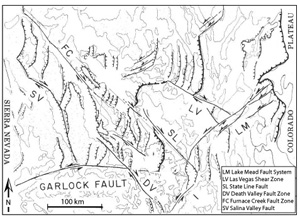 | | Figure 1. Schematic map of southern Basin and Range region showing normal faults with hatchured lines and strike-slip faults with relative motion arrows. Both fault types are believed to be of Ceneozoic in age. From Burchfiel and Davis (1988). |
Perhaps even more intriguing is the coexistence of the normal, strike-slip, and thrust faults in certain regions of Basin and Range. Figure 2 is an unambiguous example of this case from the Echo Hills in the Lake Mead National Recreational Area. We just left out pervasive normal faults in the surrounding areas for the purpose of keeping the size of the illustration reasonable but for a simplified picture the reader is referred to the eastern part of the map in Figure 1, specifically, around the Lake Mead Fault Zone (LM in the map). The Echo Hills is a structural domain between two echelon segments of a strand of the Lake Mead Fault System which is a left-lateral strike-slip fault zone with tens of kilometers offset. The eastern segment lies along the view direction in the photograph in Figure 2a closest to the viewer and raps around the domain from south. The western segment is out of the view beyond the far side of the photograph. The cross-section in Figure 2b shows: (1) the uplifted formations of the Permian and Triassic ages relative to the surroundings, (2) some older late Mesozoic thrusts, one of which folded (see double arrows) on the southwestern most part of the section, and (3) the two bounding thrusts in SW and NE sides of the Echo Hills (marked by half-arrows) responsible for the larger part of the Tertiary uplift.
 | | Figure 2. (a) Photograph (due NW) and (b) a cross section (SW-NE) of the Echo Hill push-up in the Lake Mead region showing thrust and reverse faults responsible for the Tertiary contraction and uplift of Permian and Triassic rocks confined within a domain of about 3 km long and 1.5 km wide. The boundary thrusts are marked by half arrows in the cross-section. The older, late Mesozoic thrusts within the domain, which are folded and faulted by younger folds and faults, are marked by white teeth. One of these was folded (marked by double arrows) during Tertiary. From Campagna and Aydin (1991). |
Similarly, the San Andreas transform boundary includes numerous dip-slip faults. The fault map of the San Francisco Bay area (Figure 3) is an example for such a transpressional type transform boundary, in that there are several domains characterized by thrust-reverse faults. Figure 4 shows a cross section (see Figure 3 for location) depicting the relationship between the major strike-slip faults and the thrust-reverse faults. The whole fault pattern is very similar to what is known as a flower structure comprising nearly vertical strike-slip faults and the associated diverging thrust faults. The southern section of the San Andreas Fault at the latitude of Salton Sea and the Gulf of California displays an example for the so-called transtensional transform which represents co-existing strike-slip and normal faults as well as some incipient spreading centers (Figure 5). One example for all three major types of faults within the San Andreas system is given in Figure 6. We will revisit the issue of strike-slip and normal and thrust faults relationships under fault interaction and mechanisms and mechanics of multiple faults.
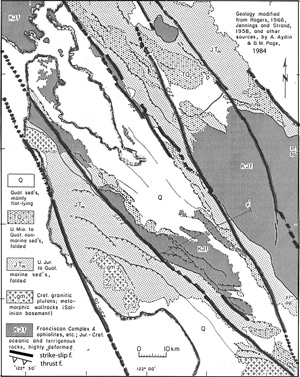 | | Figure 3. Fault pattern around the San Francisco Bay Area. The system is dominated a series of NW-trending large strike-slip faults. Also notice domains of thrust faults and folds inbetween adjacent and sometimes en echelon strike-slip faults.. It is quite possible that there are also normal fault domains such us the San Francisco Bay proper. From Aydin and Page (1984). |
 | | Figure 4. A cross section along X-X' showing the San Andreas and Calaveras right-lateral strike-slip fault zones and the related NE- and SW-verging thrust faults. Although some of the faults are believed to be inherited from pre-San Andreas regimes and provided weak zones for the transform regime, the faults shown in the section are only deforming in a self-consistent manner. The strike-slip and the upward diverging thrust fault patterns are commonly referred to as positive flower structure characteristics of transpresive strike-slip regions. Simplified from Aydin and Page (1984). |
 | | Figure 5. The southern section of the San Andreas Fault zone showing significant extension by the associated normal faults and intrusions. From Wallace (1990). The dashed lines bounding the depressions are predominantly normal faults. |
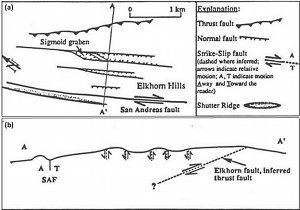 | | Figure 6. (a and b) Simplified map and cross section showing various dip-slip faults within the San Andreas transform boundary adjacent to the main fault zone. Thus, strike-slip, thrust, and normal faults are interrelated. The occurrence of strike-slip and dip-slip faults together is sometimes referred to as deformation or strain partioning. It is likely that the faults formed sequentially; from strike-slip to thrust, and eventually to normal faults. However, they have been active together. From Arrowsmith (1990). |
The next serious of figures provide some examples of thrust faults and strike-slip faults (Figures 7a, and b, Figure 8, Figure 9b, and Figure 10) and thrust faults and normal faults (Figure 7b and Figure 9a). Again, one of the thrust and strike-slip configurations (Figure 9 b) reminiscences of the tear or transform fault concept and some others (Figure 6, Figures 7a, b, Figure 8, and Figure 10) do not. A more detailed picture of the leading edge of a thrust sheet in central Apennines, Italy, displays a variety of contemporaneous faults and fractures with various kinematics (Figure 10). For the details, interested readers are referred to the references given below.
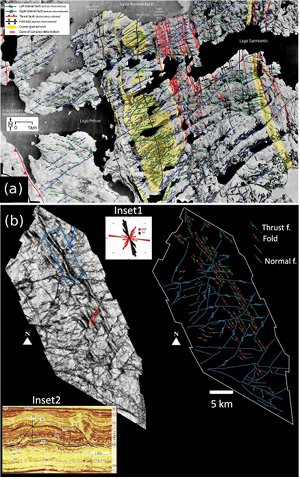 | | Figure 7. (a) Thrust faults and strike-slip faults localized within fine-grained (predominantly mudstone) and coarse-grained (sandstone and conglomerate) units in the Magallanes Foreland basin, Chilean Patagonia. From Gonzales and Aydin (2008). (b). A similar assemblage of thrust , strike-slip, and normal faults has been delineated at deep water fold and thrust belt environments driven by gravity in deltaic sediments at passive continental margins. From Oluchukwu et al. (2012). |
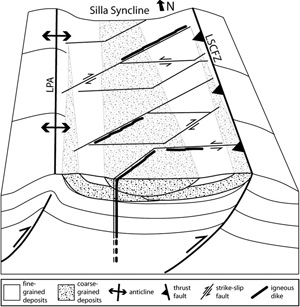 | | Figure 8. Map showing two sets of strike-slip faults and folds and thrust faults in the Andean foreland at the Chilean Patagonia, only believed to be contemperaneous. From Gonzales and Aydin (2008). |
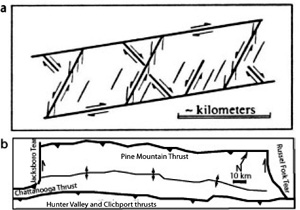 | | Figure 9. (a) Schematic map showing occurence of normal faults in thrust sheets and duplexes. From Ohlmacher and Aydin (1995). (b) The Pine Mountain thrust fault and the associated Jacksboro and Russel Fork tear faults with left- and right-lateral motions. Simplified from Rich (1934). |
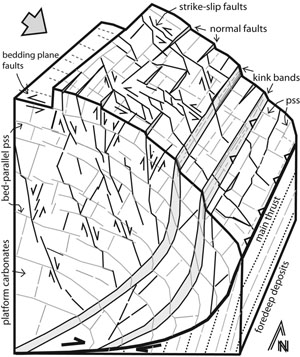 | | Figure 10. ceptual model for the structures and their orientation along the leading edge of the Maiella thrust sheet, Italy. Light gray thin-lines depict the three mutually orthogonal sets of pressure solution seams (bed-parallel, and bed-perpendicular, either strike-parallel or deep-parallel) and their sheared versions. Kink folds with associated reverse faults, antithetic and synthetic normal faults, and two sets of left- and right-lateral strike-slip faults with an apparent conjugate pattern characterize the complex nature of the deformation along the leading edge of the Maiella thrust sheet. Many of these structures appear to partially overlap in space and time. From Aydin et al. 2009. |
| |
Arrowsmith, R., 1990. Geomorphic Responses of Ephemeral Channels to Strike-Slip Faulting Near the San Andreas Fault, Carrizo Plain, California. Stanford Digital Repository. Available at:http://purl.stanford.edu/rm936qr5557.
Aydin, A., Page, B.M., 1984. Diverse Pliocene-Quaternary tectonics in a transform environment, San Francisco Bay Region, California. Geological Society of America Bulletin 95 (11): 1303-1317.
Aydin, A., Antonellini, M., Tondi, E., Agosta, F., 2010. Deformation along the leading edge of the Maiella thrust sheet in central Italy. Journal of Structural Geology 32: 1291-1304.
Burchfiel, B.C., Davis, G.A., 1988. Mesozoic Thrust and Cenozoic low-angle normal faults, eastern Spring Mountains, Nevada, and Clark Mountains Thrust Complex, California. In: Weide, D.L., Faber, M.L., This extended land, Geological Journeys in the southern Basin and Range, Geological Society of America, Cordilleran Section Field trip guidebook, p. 87-106.
Campagna, D.J., Aydin, A., 1991. Tertiary uplift and shortening in the Basin and Range; the Echo Hills, southeastern Nevada. Geology 19: 485-488.
Gonzales, J., Aydin, A., 2008. Structural characterization of deep-water deposits in foreland basin, Silla Syncline (Chilean Patagonia), with applications to depositional processes. Journal of Structural Geology 30: 1095-1108, doi:10.1016/j.jsg.2008.05.002.
Harding, T.P., Vierbuchen, R.C., Christie-Blick, N., 1985. Structural styles, plate-tectonic settings, and hydrocarbon traps of divergent (transtensional) wrench faults. In: Biddle, K.T., and Christie-Blick, N. (eds.), Strike-slip deformation, basin formation, and sedimentation. Society of Economic Paleontologists and Mineralogists Special Publication, no. 37, p. 35-45.
Hsiao, L.Y., Graham, S.A., Tilander, N., 2004. Seismic reflection imaging of a major strike-slip fault zone in a rift system: Paleogene structure and evolution of the Tan-Lu fault system, Liaodong Bay, Bohai, offshore China. American Association of Petroleum Geologists Bulletin 88: 71-98.
Hsiao, L.Y., Graham, S.A., Tilander, N., 2010. Stratigraphy and sedimentation in a rift basin modified by synchronous strike-slip deformation: Southern Xialiao Basin, Bohai, offshore China. Basin Research 22: 61-79.
Ohlmacher, G., Aydin, A., 1995. Progressive deformation and fracture patterns during foreland thrusting in the Southern Appalachians. American Journal of Science 295 (8): 943-987.
Oluchukwu, O., Cartwright, J.A., Briggs, S., 2012. Interaction between thrust faults and strike-slip faults in deep water fold and thrust belts: Example from the Levant Basin, Eastern Mediterranean Sea. AAPG Annual Convention and Exhibition, Long Beach, California, April 22-25, 2012.
Rich, J.L., 1934. Mechanics of low-angle overthrust faulting as illustrated by the Cumberland thrust block, Virginia, Kentucky and Tennessee. American Association of Petroleum Geologists Bulletin 18: 1584-1596.
|









